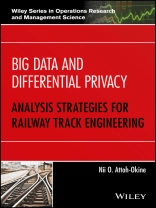A comprehensive introduction to the theory and practice of contemporary data science analysis for railway track engineering
Featuring a practical introduction to state-of-the-art data analysis for railway track engineering, Big Data and Differential Privacy: Analysis Strategies for Railway Track Engineering addresses common issues with the implementation of big data applications while exploring the limitations, advantages, and disadvantages of more conventional methods. In addition, the book provides a unifying approach to analyzing large volumes of data in railway track engineering using an array of proven methods and software technologies.
Dr. Attoh-Okine considers some of today’s most notable applications and implementations and highlights when a particular method or algorithm is most appropriate. Throughout, the book presents numerous real-world examples to illustrate the latest railway engineering big data applications of predictive analytics, such as the Union Pacific Railroad’s use of big data to reduce train derailments, increase the velocity of shipments, and reduce emissions.
In addition to providing an overview of the latest software tools used to analyze the large amount of data obtained by railways, Big Data and Differential Privacy: Analysis Strategies for Railway Track Engineering:
* Features a unified framework for handling large volumes of data in railway track engineering using predictive analytics, machine learning, and data mining
* Explores issues of big data and differential privacy and discusses the various advantages and disadvantages of more conventional data analysis techniques
* Implements big data applications while addressing common issues in railway track maintenance
* Explores the advantages and pitfalls of data analysis software such as R and Spark, as well as the Apache(TM) Hadoop® data collection database and its popular implementation Map Reduce
Big Data and Differential Privacy is a valuable resource for researchers and professionals in transportation science, railway track engineering, design engineering, operations research, and railway planning and management. The book is also appropriate for graduate courses on data analysis and data mining, transportation science, operations research, and infrastructure management.
NII ATTOH-OKINE, Ph D, PE is Professor in the Department of Civil and Environmental Engineering at the University of Delaware. The author of over 70 journal articles, his main areas of research include big data and data science; computational intelligence; graphical models and belief functions; civil infrastructure systems; image and signal processing; resilience engineering; and railway track analysis. Dr. Attoh-Okine has edited five books in the areas of computational intelligence, infrastructure systems and has served as an Associate Editor of various ASCE and IEEE journals.
Cuprins
Preface xi
Acknowledgments xiii
1 Introduction 1
1.1 General 1
1.2 Track Components 2
1.3 Characteristics of Railway Track Data 4
1.4 Railway Track Engineering Problems 6
1.5 Wheel-Rail Interface Data 11
1.6 Geometry Data 15
1.7 Track Geometry Degradation Models 20
1.8 Rail Defect Data 25
1.9 Inspection and Detection Systems 33
1.10 Rail Grinding 37
1.11 Traditional Data Analysis Techniques 40
1.12 Remarks 41
References 42
2 Data Analysis – Basic Overview 49
2.1 Introduction 49
2.2 Exploratory Data Analysis (EDA) 49
2.3 Symbolic Data Analysis 53
2.4 Imputation 54
2.5 Bayesian Methods and Big Data Analysis 56
2.6 Remarks 57
References 57
3 Machine Learning: A Basic Overview 59
3.1 Introduction 59
3.2 Supervised Learning 60
3.3 Unsupervised Learning 61
3.4 Semi-Supervised Learning 61
3.5 Reinforcement Learning 61
3.6 Data Integration 63
3.7 Data Science Ontology 63
3.8 Imbalanced Classification 69
3.9 Model Validation 70
3.10 Ensemble Methods 71
3.11 Big P and Small N (P ?â N) 74
3.12 Deep Learning 79
3.13 Data Stream Processing 95
3.14 Remarks 105
References 105
4 Basic Foundations of Big Data 113
4.1 Introduction 113
4.2 Query 116
4.3 Taxonomy of Big Data Analytics in Railway Track Engineering 123
4.4 Data Engineering 124
4.5 Remarks 130
References 130
5 Hilbert-Huang Transform, Profile, Signal, and Image Analysis 133
5.1 Hilbert-Huang Transform 133
5.2 Axle Box Acceleration 150
5.3 Analysis 151
5.4 Remarks 153
References 153
6 Tensors – Big Data in Multidimensional Settings 157
6.1 Introduction 157
6.2 Notations and Definitions 158
6.3 Tensor Decomposition Models 161
6.4 Application 164
6.5 Remarks 170
References 171
7 Copula Models 175
7.1 Introduction 175
7.2 Pair Copula: Vines 184
7.3 Computational Example 186
7.4 Remarks 192
References 193
8 Topological Data Analysis 197
8.1 Introduction 197
8.2 Basic Ideas 197
8.3 A Simple Railway Track Engineering Application 203
8.4 Remarks 204
References 204
9 Bayesian Analysis 207
9.1 Introduction 207
9.2 Markov Chain Monte Carlo (MCMC) 210
9.3 Approximate Bayesian Computation 210
9.4 Markov Chain Monte Carlo Application 216
9.5 ABC Application 219
9.6 Remarks 221
References 222
10 Basic Bayesian Nonparametrics 225
10.1 General 225
10.2 Dirichlet Family 226
10.3 Dirichlet Process 227
10.4 Finite Mixture Modeling 231
10.5 Bayesian Nonparametric Railway Track 232
10.6 Remarks 233
References 233
11 Basic Metaheuristics 235
11.1 Introduction 235
11.2 Remarks 237
References 239
12 Differential Privacy 241
12.1 General 241
12.2 Differential Privacy 242
12.3 Remarks 247
References 247
Index 249
Despre autor
Nii Attoh-Okine, Ph D, PE is Professor in the Department of Civil and Environmental Engineering at the University of Delaware. The author of over 70 journal articles, his main areas of research include big data and data science; computational intelligence; graphical models and belief functions; civil infrastructure systems; image and signal processing; resilience engineering; and railway track analysis. Dr. Attoh-Okine has edited five books in the areas of computational intelligence, infrastructure systems and has served as an Associate Editor of various ASCE and IEEE journals.












